The Week in Charts series showcases charts that help explain a rapidly changing world—as we strive for sustainable, inclusive growth. This year, we’ve curated 12 compelling data visualizations that capture insights on the transformative power of digital and AI, resilience in the face of uncertainty, the evolving landscape of talent trends, the intersection of equity and health, and more.
Gaining an edge with AI and digital
Investment in AI and digital technologies reflected organizations’ commitment, despite economic headwinds, to advance innovation and build new businesses—and helped some to outperform peers.
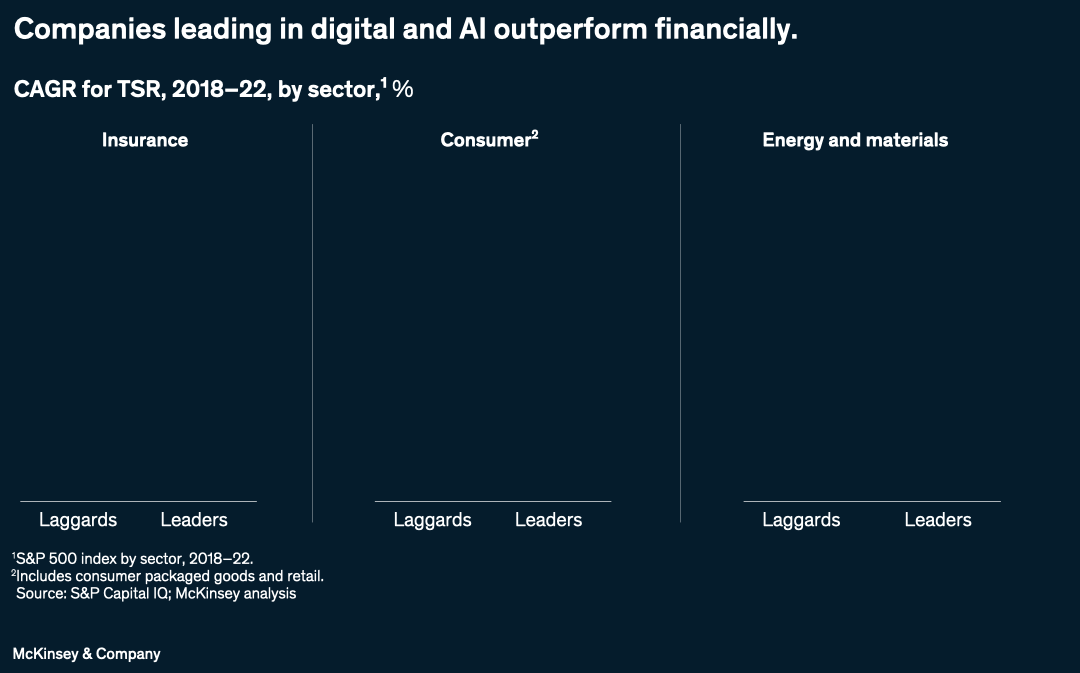
Image description:
A series of 3 comparison volume circles show compound annual growth rates from 2018 to 2022 for shareholder returns as a percentage for companies that are either laggards or leaders in the use of digital and AI in their industry. The insurance industry has laggards at 1.1% growth per annum and leaders at 6.7% growth per annum; consumer (including consumer packaged goods and retail) has laggards at 3.2% growth per annum and leaders at 9.4% growth per annum; and energy and materials has laggards at 5.0% growth per annum and leaders at 11.6% growth per annum.
Source: S&P Capital IQ; McKinsey analysis.
End of image description.
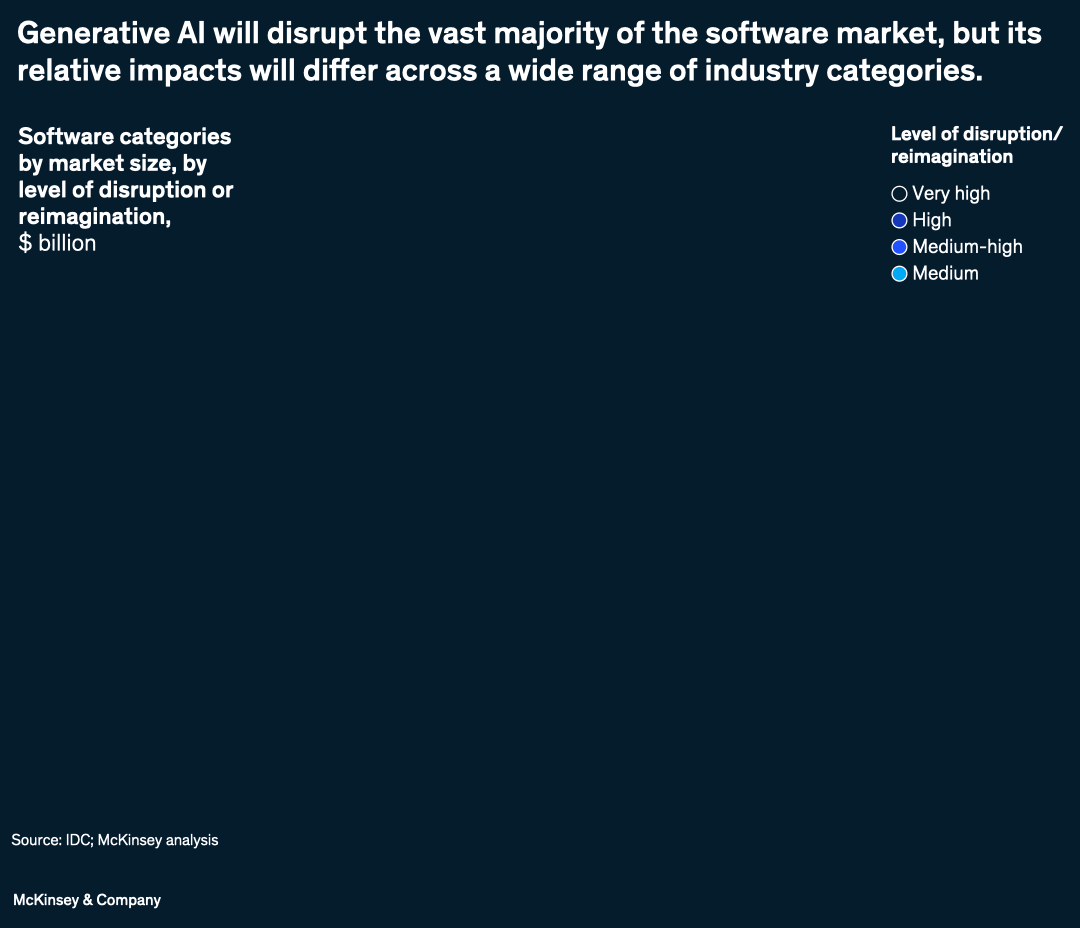
Image description:
A Voronoi diagram shows the market size of different software industry segments within the software marketplace, in billions of dollars. The segments are color-coded by level of disruption/reimagination. Content creation, customer service, and information services/data integration show a very high level of disruption. Data and AI development, analytics/visualization, collaboration/communication, and enterprise automation show a high level of disruption. Cybersecurity, application development, and customer relationship management show a medium-high level of disruption. System infrastructure shows a medium level of disruption.
Source: IDC; McKinsey analysis.
End of image description.
Planning for tight talent markets
Global economies are grappling with shifts in labor force participation. To shape a resilient future, leaders must look to reskilling and upskilling talent and consider new policies to address employee needs.

Image description:
Eight line charts, 1 for each of the highlighted countries, plot actual labor force growth from 2010 to 2023 and projected growth from 2023 to 2030. The line splits into 2 at 2023, representing stable and growing participation rate scenarios. The growing scenario lines are higher than the 2023 level across all countries except Germany and Italy. The stable scenario lines are lower than the 2023 level for France, Germany, Italy, and Japan. They are higher for Australia, Canada, the UK, and the US.
Source: International Labour Organization; UK Office for National Statistics; UN Population Prospects; McKinsey Global Institute analysis.
End of image description.
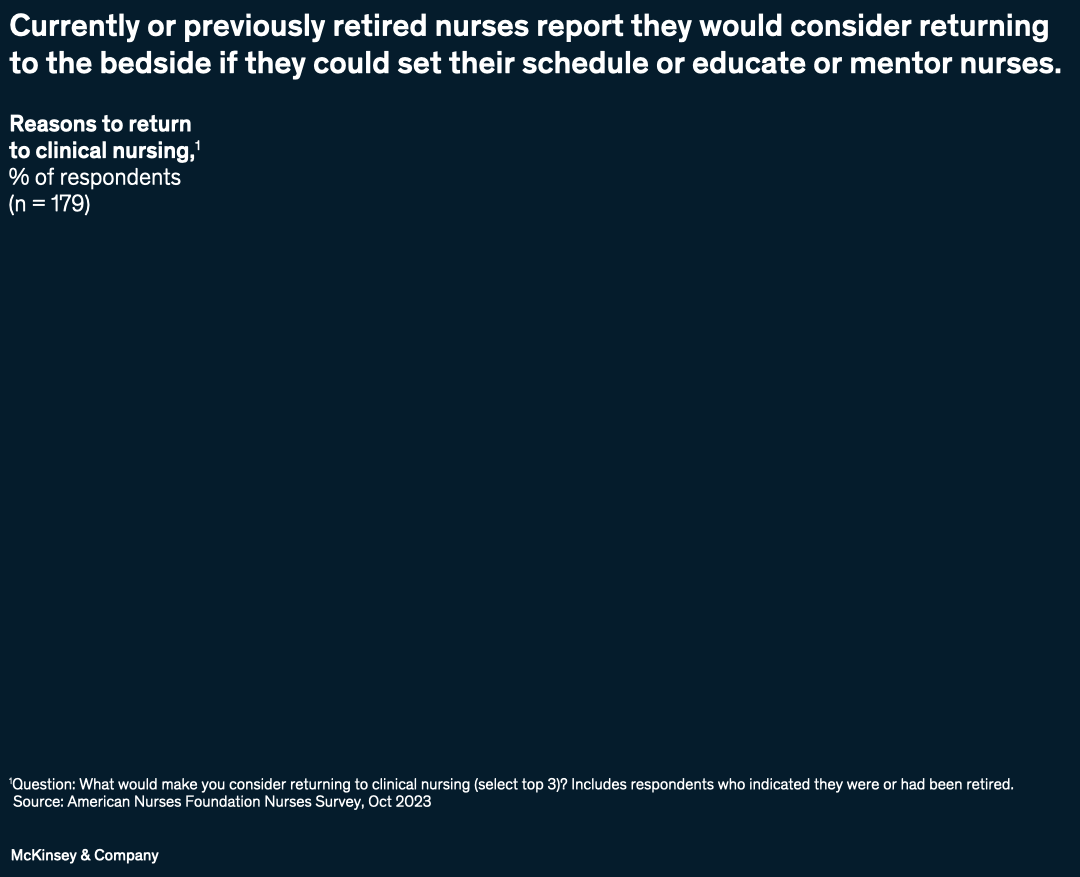
Image description:
A bar chart shows the motivations for returning to clinical nursing among respondents who are currently retired or were previously retired. Respondents’ reasons, in descending order, are as follows: ability to set my own schedule at 45%, ability to serve as an educator at 34%, ability to mentor nurses at 31%, reduced hours overall at 28%, no weekend work at 21%, enhanced benefits at 21%, ability to interact with patients at 20%, ability to have virtual shifts at 20%, reduced patient load at 19%, more support for physical tasks at 16%, no night work requirements at 12%, work in a different location or site at 9%, and flexible shift length at 5%.
Footnote: Question: What would make you consider returning to clinical nursing (select top 3)? Includes respondents who indicated they were or had been retired.
Source: American Nurses Foundation Nurses Survey, Oct 2023.
End of image description.
Fostering a resilient future
Demand for talent was just one of many strains across regions and sectors this year, as geopolitical tumult and economic uncertainty also featured prominently. But organizations found ways to maneuver and position themselves to thrive.
Ongoing geopolitical issues are contributing to a reconfiguration of global trade that could follow one of two scenarios. In one, heightened trade frictions between geopolitically misaligned economies would cause trade to reorient and flow to those in greater geopolitical agreement. In another scenario, import concentration in trade relationships would reduce, meaning no economy would be overly dependent on another for its imports. The outcome from either scenario has potential drawbacks—increased trade concentration could lower geopolitical risks, but it could also reduce economic growth, while diversification could increase geopolitical misalignment between economies.
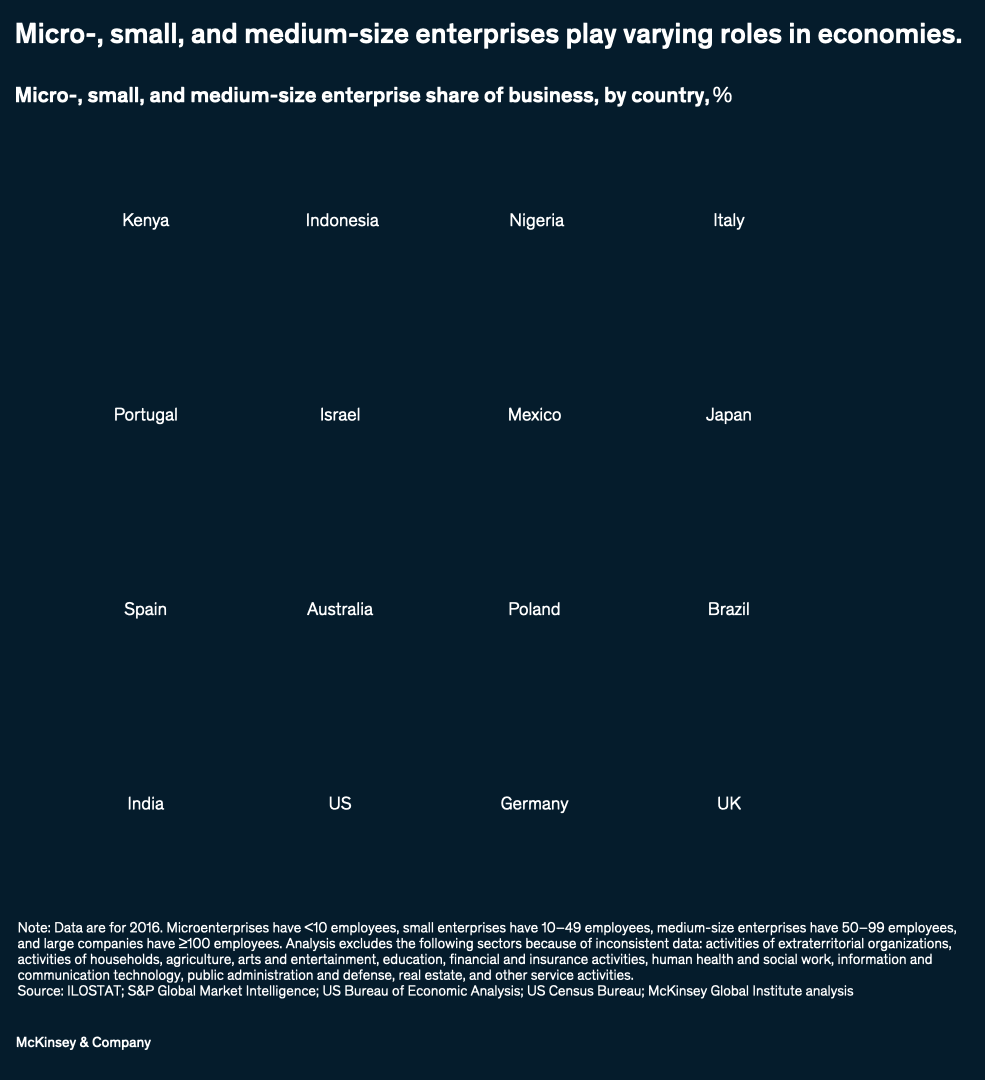
Image description:
Pie bar charts show the share of business employment and the share of business value added for micro-, small, and medium-size enterprises (MSMEs) across 16 nations. The top 4 nations for share of business employment for MSMEs are Kenya at 96%, Indonesia at 87%, Nigeria at 83%, and Italy at 76%. The bottom 4 nations for that metric are the United Kingdom at 52%, the US at 58%, Germany at 57%, and India at 62%. The top 4 nations for share of business value added for MSMEs are Portugal at 67%, Indonesia at 64%, Israel at 64%, and Italy at 63%. The bottom 4 nations for that metric are India at 30%, Nigeria at 36%, the US at 39%, and Germany at 45%.
Source: ILOSTAT; S&P Global Market Intelligence; US Bureau of Economic Analysis; US Census Bureau; McKinsey Global Institute analysis.
End of image description.
Finding a path to sustainability
It’s an uphill climb to reach global net-zero emissions. Navigating a path toward success involves greater innovation, investment, and coordination among global stakeholders.
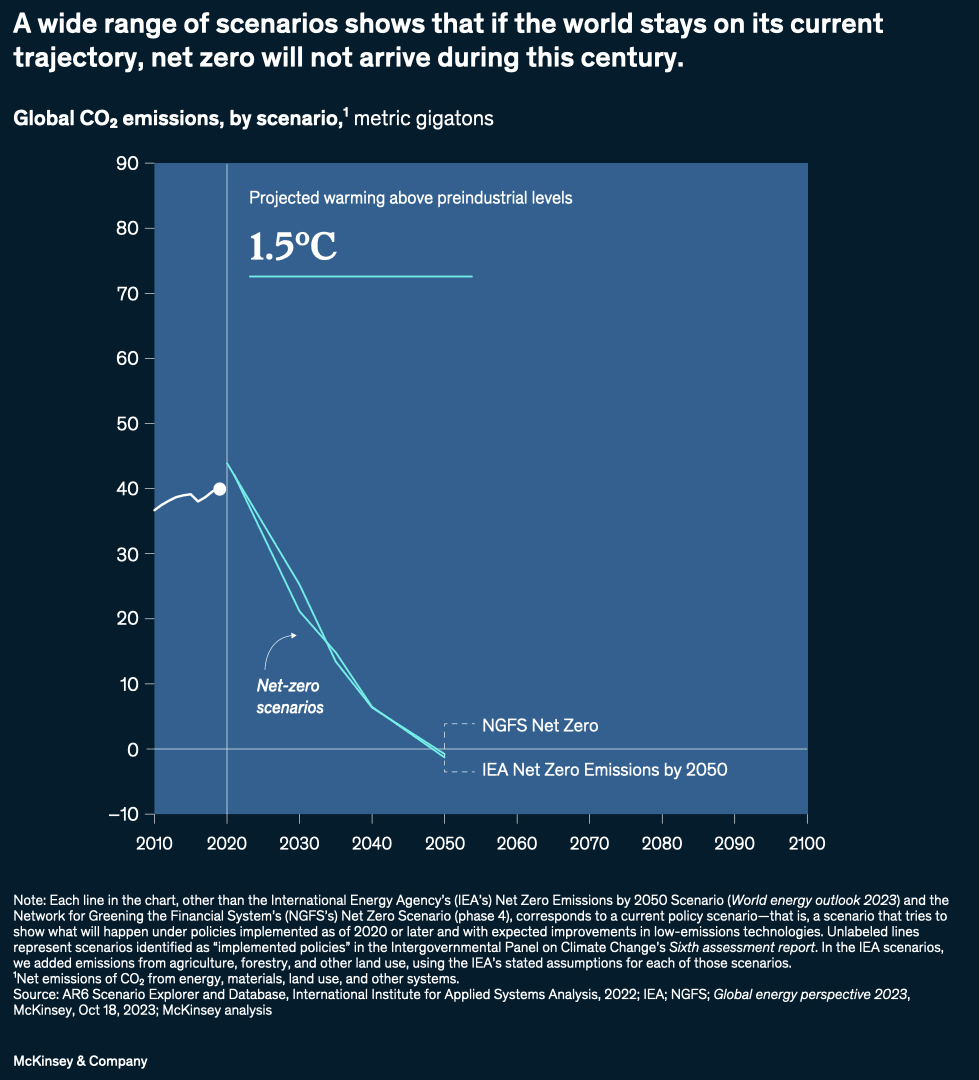
Image description:
A line chart shows global CO2 emissions in metric gigatons, by scenario. The line chart animates, showing different scenarios by projected warming ranges from a variety of projections. Overall, a wide range of scenarios indicate that if the world stays on its current trajectory, net zero will not arrive during this century.
Source: AR6 Scenario Explorer and Database, International Institute for Applied Systems Analysis, 2022; International Energy Agency; Network for Greening the Financial System; Global energy perspective 2023, McKinsey, Oct 18, 2023; McKinsey analysis.
End of image description.
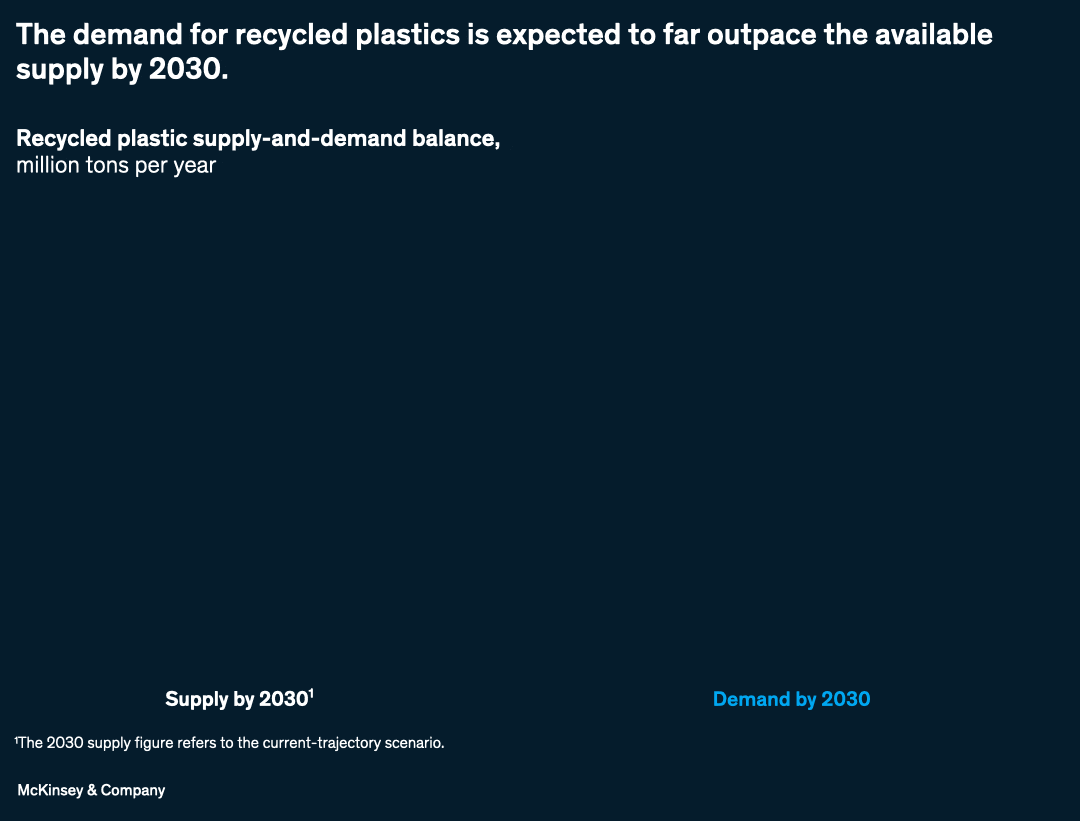
Image description:
Two groups of plastic-product illustrations provide a simple comparison of the expected supply of recycled plastic in 2030, estimated to be around 60 million tons with the current-trajectory scenario, and its expected demand in 2030, estimated to be around 90 million tons.
End of image description.
Pursuing parity
Improving economic mobility, diversifying workforces, harnessing technology to close racial divides: these and other equity goals still matter to global stakeholders, but progress has stalled on efforts that could meaningfully improve lives and livelihoods.
Without substantial progress toward improving outcomes for Black Americans, it could take more than 300 years for them to achieve parity with White Americans, based on current rates of change. Even the best cases would take more than a century. To make meaningful progress and prevent disparities from lingering into future generations, stakeholders in public and private sectors will have to engage on solutions such as affordable housing and early childhood education.
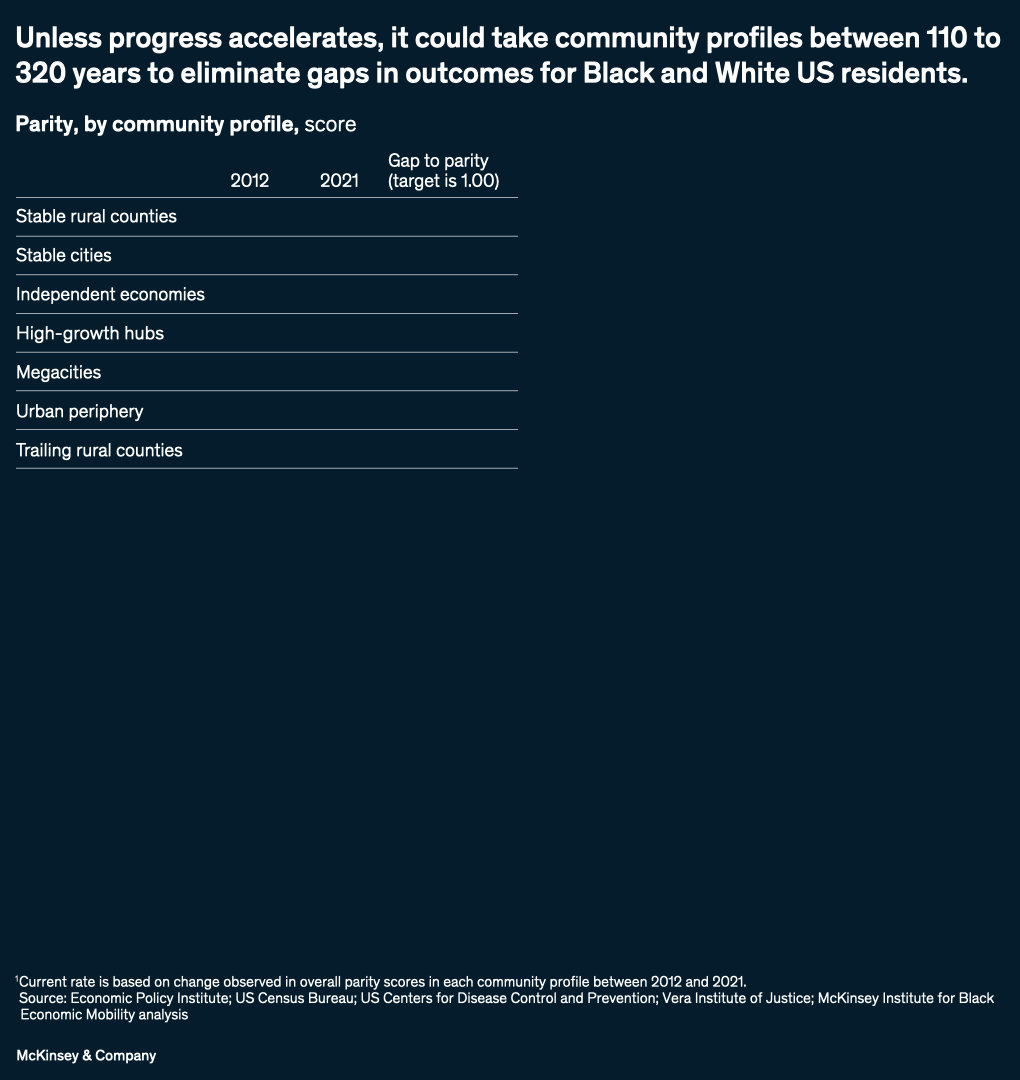
Image description:
A bar chart shows the time to reach racial parity for different community archetypes in the US if they continue at their rate of parity score change between 2012 and 2021. It could take stable rural counties ~320 years to reach parity, stable cities ~240 years, independent economies ~220 years, high-growth hubs ~210 years, megacities ~160 years, the urban periphery ~120 years, and trailing rural counties ~110 years.
Source: Economic Policy Institute; US Census Bureau; US Centers for Disease Control and Prevention; Vera Institute of Justice; McKinsey Institute for Black Economic Mobility analysis.
End of image description.
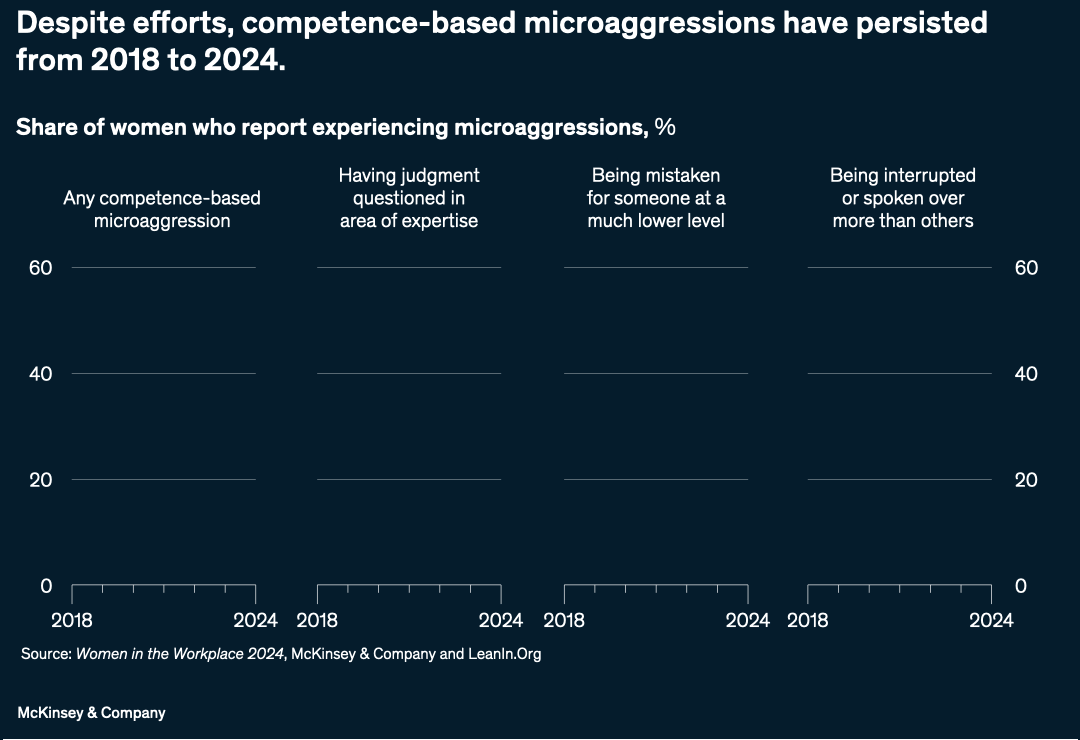
Image description:
Four line graphs show the share of women who report experiencing various types of competence-based microaggressions from 2018 to 2024. In 2018, 43% of women reported experiencing at least 1 type, peaking at ~63% in 2019, then declining steadily to ~35% over the next 3 years, before rising to ~55% in 2024. The share of women whose judgment was questioned in their area of expertise was 37% in 2018, rose to 39% in 2019, then fell to 23% by 2023, before returning to ~39%[QA1] in 2024. Those mistaken for someone at a much lower level remained steady at between 18 and 20% over the same period. Finally, 51% reported being interrupted or spoken over more than others in 2018; this decreased to ~23%[QA2] in 2023, then rose to ~40% in 2024.
Source: Women in the Workplace 2024, McKinsey & Company and LeanIn.Org.
End of image description.
Prioritizing inclusive health
Better quality of life is possible at a global scale. But getting there requires public and private sector leaders to identify gaps in care and coordinate on initiatives with measurable outcomes.
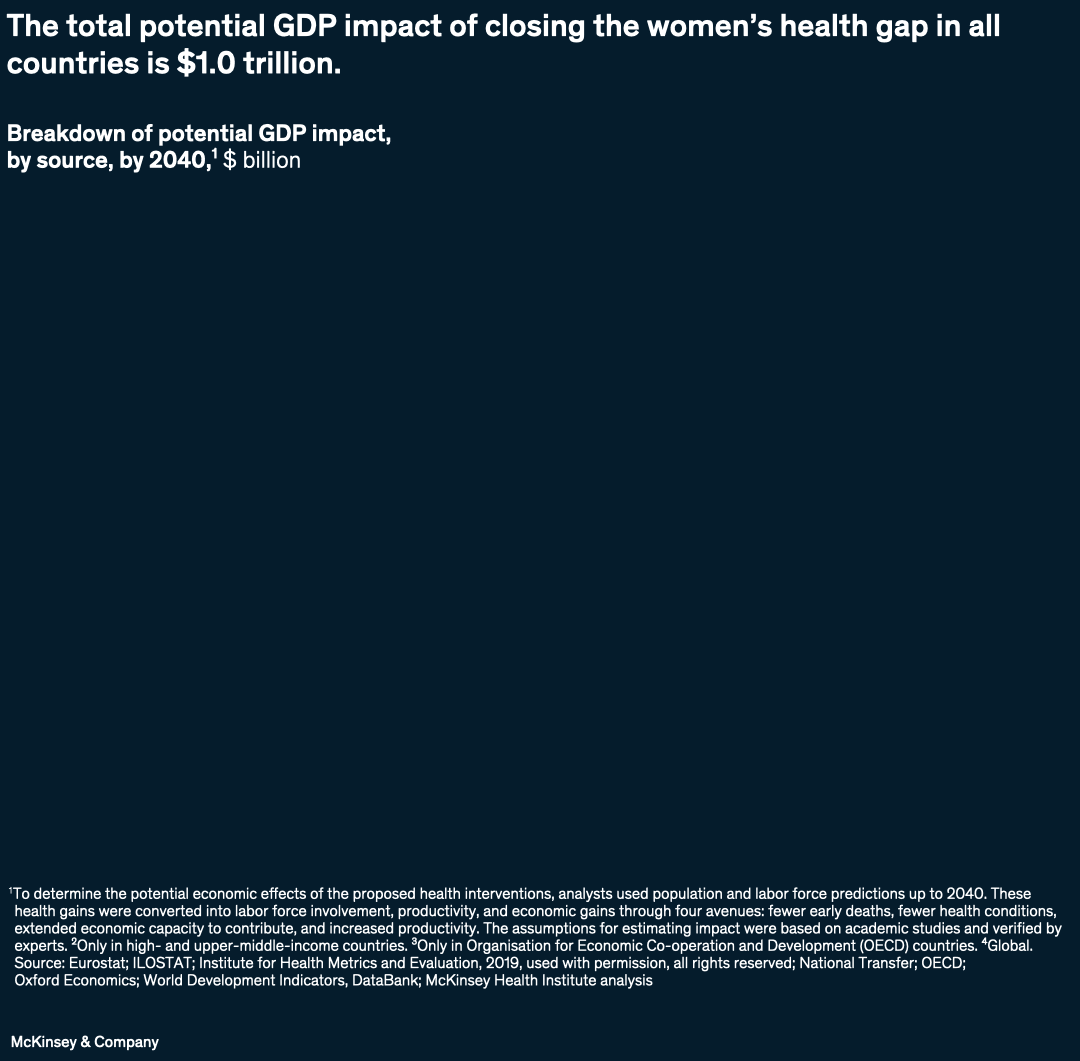
Image description:
An area tree map shows the potential GDP impact of closing the women’s health gap globally by 2040. The total value of closing the gap is $1.0 trillion. The gain is broken down into 4 health intervention segments. To determine the potential economic effect of the segments, analysts used population and labor force predictions up to 2040. The assumptions for estimating impact were based on academic studies and verified by experts. Achieving fewer health conditions, described as the prevention of premature deaths to extend active life in women, where women are at a disadvantage to men today, has a gain of $390.6 billion. Increasing productivity, described as an increase in economic participation of women with disabilities or informal caregivers, has a gain of $229.8 billion. Expanding participation, described as a boost in the productivity of women and the future earnings potential of girls, where they are at a disadvantage to men, and including impact on older adults in high- and upper-middle-income countries, informal caregivers in Organisation for Economic Co-operation and Development (OECD) countries, and people with disabilities, has a gain of $240.3 billion. And having fewer early deaths, described as a reduction in disability in women, where women are at a disadvantage to men today, leading to decreased absenteeism or increased working hours has a gain of $165.1 billion. Source: Eurostat; ILOSTAT; Institute for Health Metrics and Evaluation, 2019, used with permission, all rights reserved; National Transfer; OECD; Oxford Economics; World Development Indicators, DataBank; McKinsey Health Institute analysis.
End of image description.
Reducing health inequities among all people who live in cities across the world could unlock 20 billion to 25 billion additional years of higher-quality life. That’s roughly five years per person living in an urban area if interventions are effectively deployed. There are four categories of interventions: healthy longevity, brain health, climate-related health, and healthy-worker capacity interventions. The number of people living in cities is expected to increase to 70 percent of the global population by 2050, which makes enhancing health interventions key to improving lives and livelihoods.
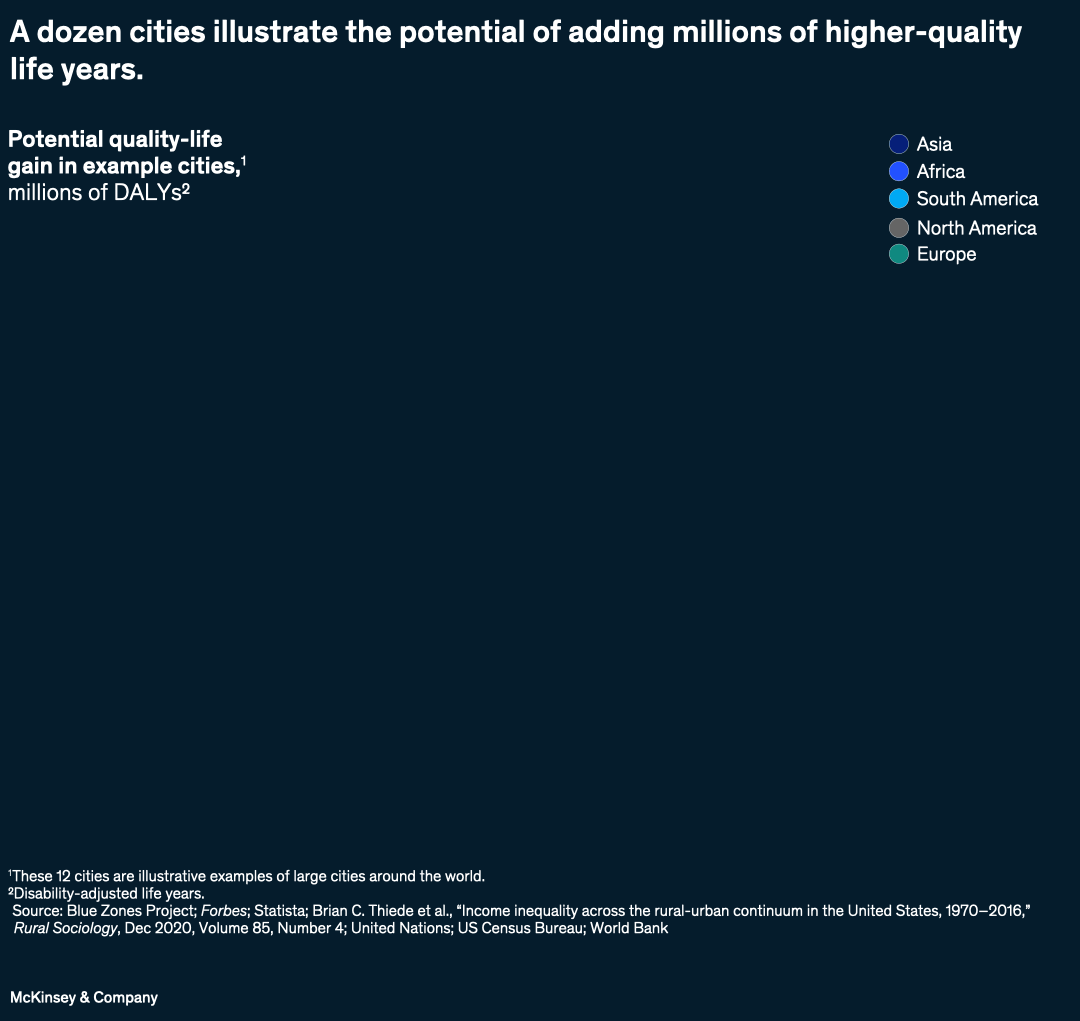
Image description:
A series of circles represent the ranges of potential quality-life gain in 12 cities illustrative of large cities around the world, with the gain measured in millions of disability-adjusted years of life. From largest to smallest, they are Tokyo at 140 million to 190 million, Mumbai at 130 million to 180 million, Lagos at 100 million to 130 million, Beijing at 80 million to 110 million, São Paolo at 80 million to 110 million, New York at 70 million to 100 million, Paris at 40 million to 60 million, London at 40 million to 50 million, Nairobi at 30 million to 40 million, Santiago at 30 million to 40 million, Singapore at 20 million to 30 million, and Dubai at 10 million to 20 million.
Source: Blue Zones Project; Forbes; Statista; Brian C. Thiede et al., “Income inequality across the rural-urban continuum in the United States, 1970–2016,” Rural Sociology, Dec 2020, Volume 85, Number 4; United Nations; US Census Bureau; World Bank.
End of image description.
To get a roundup of charts delivered weekly to your inbox, sign up for The Week in Charts newsletter.

